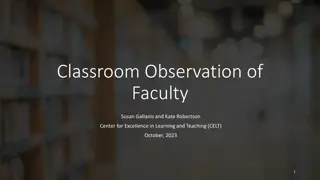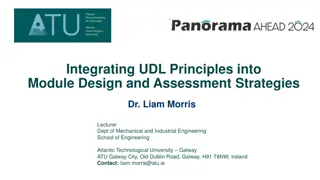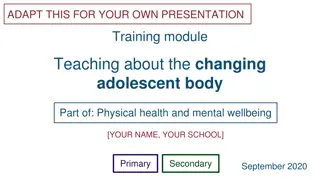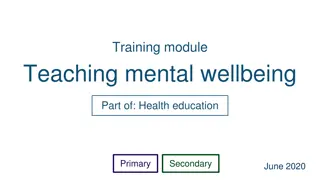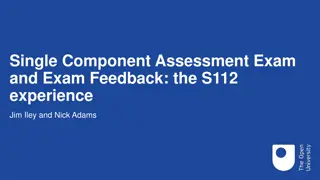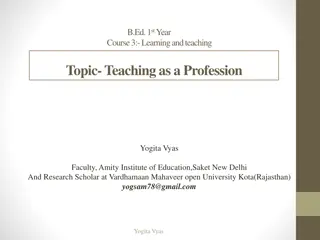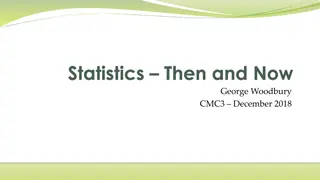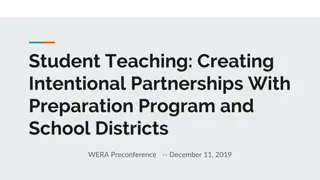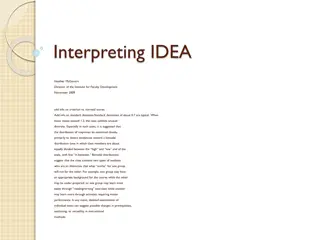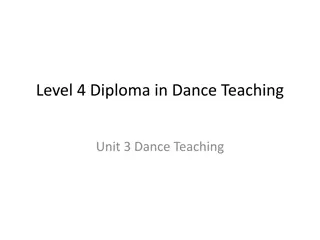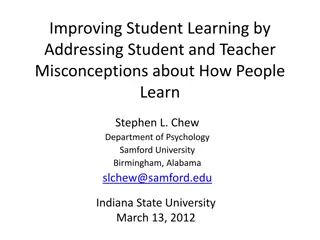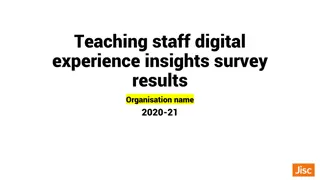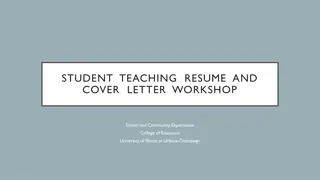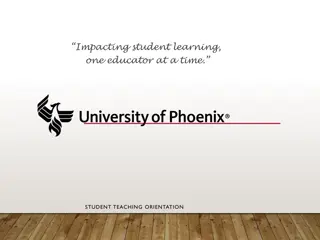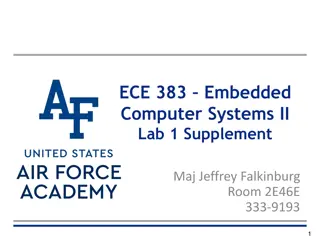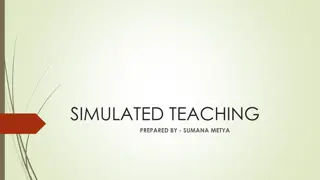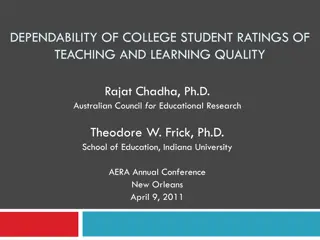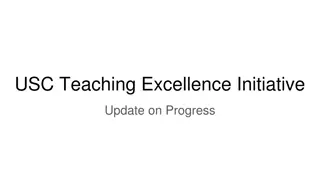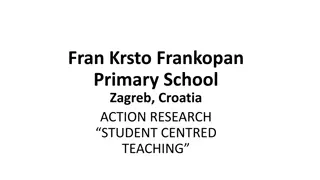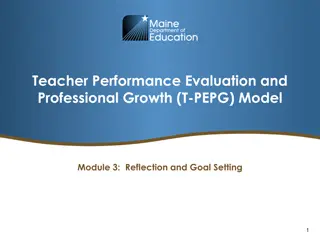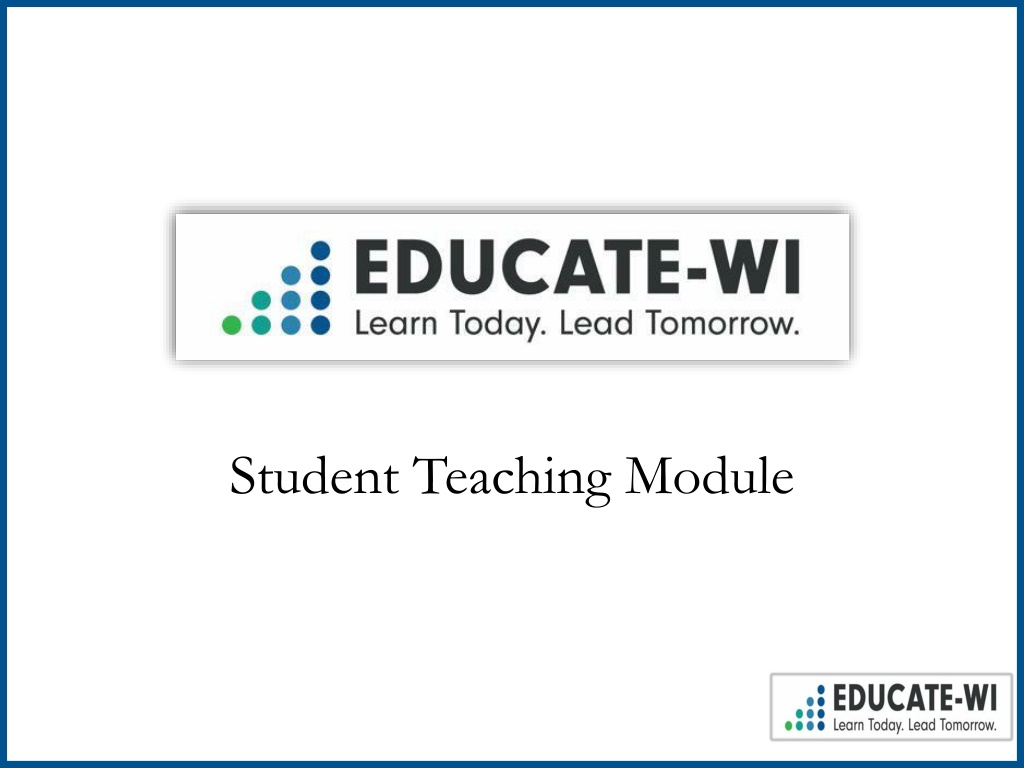
Benefits of Student Teaching and Requirements Explained
Discover the reasons for student teaching, where and when it takes place, what to expect during the student teaching semester, and who is involved. Get insights into the eligibility criteria and the structure of the student teaching program to help you prepare effectively.
Download Presentation

Please find below an Image/Link to download the presentation.
The content on the website is provided AS IS for your information and personal use only. It may not be sold, licensed, or shared on other websites without obtaining consent from the author. Download presentation by click this link. If you encounter any issues during the download, it is possible that the publisher has removed the file from their server.
E N D
Presentation Transcript
Why must I student teach? Where will I student teach? When will I student teach? What will the student teaching semester look like? Who is involved in the student teaching semester?
Why must I student teach? Candidates who have successfully completed the program coursework must complete student teaching. If you are currently teaching fulltime under a 1-Year License with Stipulations, you will be evaluated as a student teacher. Students seeking an initial certification Students seeking an additional certification will complete their student teaching within a 9-week timeframe. must student teach full days for a full semester (Wis. Stats. 118.19(3)(a)).
Where will I student teach? Per PI 34.023 (1), students are required to student teach in the subject area and developmental level in which they are seeking certification. If you are working on a 1-year license with stipulations in the subject area and age level you are getting certified in, student teaching can be set up on the job. If you are not working on a 1-year license with stipulations, you will have the opportunity to request placement in specific districts. Your program administrator will contact the school district(s) and request placement. (Students do not set up their own student teaching placement.) 10 Sped: -Early Childhood Special Education (birth-3rd grade) -Cross Categorial Special Education (K-12) Project Teaching -Subject area and grade level you are seeking.
When will I student teach? Student teaching is the final semester of the program 10 Sped: Semester IV (EDWN 612) Project Teaching: Semester III (EDWN 612) In order to be eligible to student teach: 1. The student must have completed and passed all required coursework. 10 Sped Students: EDWN 605, EDWN 606, EDWN 608 Project Teaching Students: EDWN 600, EDWN 603 2. The student must have passed all pre-student teaching requirements.
What will the student teaching semester look like? Student Teaching Requirements: The student must be assigned a cooperating teacher or team of cooperating teachers. The student teaching experiences must be developmental in scope and sequence, occur in school settings, and meet the statutory requirements identified in s. 118.19 (3)(a), Stats. The student teaching experience must provide the student the opportunity to interact with and adapt instruction for students with disabilities. Students must demonstrate greater knowledge and understanding of the Wisconsin 10 Teacher Standards, Communication Skills, Human Relations and Professional Dispositions, Content Knowledge, and Pedagogical Knowledge as demonstrated by a proficiency rating on the cooperating teacher and supervisor performance evaluations.
PI34 Evaluation Requirements Student Teaching Evaluation Rubric based on the 10 Wisconsin Teacher Standards is provided by Educate-WI. Both the cooperating teacher and the Educate-WI supervisor will use the Student Teaching Evaluation Rubric to measure student proficiency on the 10 Wisconsin Teacher Standards. For students seeking initial certification: The cooperating teacher will complete two evaluations and participate in three conferences with the student teacher and supervisor throughout the semester. The Supervisor will conduct three observations/evaluations and participate in three conferences with the student teacher and cooperating teacher throughout the semester. For students seeking additional certification, The cooperating teacher will complete at least one evaluation and participate in one conference with the student teacher and supervisor. The Supervisor will complete at least one evaluation and participate in one conference with the student teacher and cooperating teacher. This could be one conference if both observations and evaluations are conducted at the same time. If the student does not demonstrate proficiency, additional evaluations will be required.
Student Teaching Evaluation Requirements Initial certification seeking student: Additional certification seeking student: Initial certification seeking student teachers must student teach full days for a full semester (16 weeks) and follow the cooperating teacher s schedule. . The supervisor must complete three observations and evaluations in person or real time virtual. One observation and evaluation must be done in person. The cooperating teacher must complete two observations and evaluations. Evaluations should be scheduled at regular intervals throughout the semester to allow students to develop necessary skills. The cooperating teacher, student teacher, and supervisor must conference after each evaluation (for a total of three times). Additional certification seeking student teachers must demonstrate proficiency within a 9-week timeframe. A minimum of one observation and evaluation must be completed by the cooperating teacher. A minimum of one observation and evaluation must be completed by the supervisor. The cooperating teacher, student teacher, and supervisor must conference after each evaluation (could be one conference if both observations and evaluations are conducted at the same time). If the student does not demonstrate proficiency, additional evaluations will be required.
Student Teacher Responsibilities Keep the contractual schedules/hours/days of their cooperating teachers and be on time Assume all the contractual responsibilities and expectations the school/district has of their teachers Assume this responsibility in a gradual sequence with opportunities to observe and learn from cooperating teachers Spend the time necessary outside of school to prepare for student teaching responsibilities Demonstrate disposition for teacher (both professionally and ethically) Dress professionally according to the dress codes of the school Ascertain permission from their cooperating teachers for all the activities they do on the school site Provide lesson plan to cooperating teacher and Educate-WI Supervisor prior to each observation. Be observed in their assigned classrooms by cooperating teacher and Educate-WI supervisor, to participate in conferences where they will receive feedback from cooperating teacher and supervisor, and to participate in the performance evaluation process. Follow directions given in writing or orally from the cooperating teacher and Educate-WI supervisor. Ask questions for clarification and/or for any help they need with placement assignments, course assignments, etc. Keep in mind that you are a guest in the classroom. Please remember that the Cooperating Teacher you are with, volunteered to have you in their classroom. The student teacher is not able to make changes to the classroom environment, curriculum, or the behavior management plan without the consent of the Cooperating Teacher.
Both the cooperating teacher and the Educate-WI supervisor will use the Student Teaching Practicum Evaluation Rubric to measure student proficiency on the 10 Wisconsin Teacher Standards. Student Teaching Practicum Evaluation Rubric Wisconsin State Standard #1: LEARNER DEVELOPMENT The teacher understands how pupils grow and develop, recognizing that patterns of learning and development vary individually within and across the cognitive, linguistic, social, emotional and physical areas. The teacher designs and implements developmentally appropriate and challenging learning expriences for pupils. Score Comments Level 5: Advanced Assesses individual development and connects learning tasks with learner experiences in a way that encourages learners to assume responsibility for their learning. Level 4: Advanced Assesses individual development and seeks to connect learning tasks with learner experiences. Level 3: Proficient Aware of individual development, but does not always successfully connect learning tasks with learner experiences. Level 2: Emerging Attempts to assess individual development and occasionally connects learning tasks with learner experiences. Level 1: Emerging Does not assess individual development or connect learning tasks with learner experiences. Wisconsin State Standard #2: LEARNING DIFFERENCES The teacher uses his or her understanding of individual pupil differences and diverse cultures and communities to ensure inclusive learning environments that enable each pupil to meet high standards. Score Comments Level 5: Advanced Consistently provides instruction to meet divers learner needs. Differentiates for individual learners, connecting with their personal and community assets. Level 4: Advanced Makes appropriate provisions for learners who have different approaches to learning, employing assistive technology is required. Level 3: Proficient Makes provisions for learners who have different approaches to learning, but does not always adapt instruction successfully. Level 2: Emerging Understands appropriate provisions for individual learners who have different approaches to learning, but seldom adapt instruction. Level 1: Emerging Does not make provisions for learners who have different approaches to learning.
Student Teaching Practicum Evaluation Rubric cont. Wisconsin State Standard #3: LEARNING ENVIRONMENTS The teacher works with others to create environments that support individual and collaborative learning, and that encourage positive social interaction, active engagement in learning, and self-motivation. Score Comments Level 5: Advanced Actively and equitably engages learners, building learner capability to show respect for one another. Level 4: Advanced Establishes and enforces clear expectations of learner behavior. Level 3: Proficient Establishes but enforces expectations of learner behavior inconsistently. Level 2: Emerging Adds rules after problems arise. Neglects to state expectations, Level 1: Emerging doesn't enforce them. Wisconsin State Standard #4: CONTENT KNOWLEDGE The teacher understands the central concepts, tools of inquiry, and structures of each discipline he or she teaches. The teacher createas learning experiences that make the discipline accessible and meaningful for pupils to assure mastery of the content. Score Comments Level 5: Advanced Can explain complex ideas from subject area. Engages learners to demonstrate inquiry skills appropriate to the subject area. Stimulates learner reflection. Level 4: Advanced Can explain complex ideas from subject area. Engages learners to demonstrate inquiry skills appropriate to the subject area. Level 3: Proficient Understands but can't explain some complex ideas. Is will to say, "I don't know." Level 2: Emerging Explains the basics, but gets stuck easily. Is flustered by not knowing. Level 1: Emerging Asserts incorrect information. Will make up something instead of not knowing.
Student Teaching Practicum Evaluation Rubric cont. Wisconsin State Standard #5: APPLICATION OF CONTENT The teacher understands how to connect concepts and use differing perspectives to engage pupils in critical thinking, creativity, and collaborative problem solving related to authentic local and global issues. Score Comments Level 5: Advanced Engages learners in applications of content using current tools and real world problems. Seeks to enhance learner communication within the content according to diverse perspectives. Level 4: Advanced Engages learners in applications of content using current tools and real world problems. Seeks to enhance learner communication within the content. Level 3: Proficient Engages learners in understanding content. Seeks to enhance learner communication within the content. Level 2: Emerging Engages learners inconsistently in understanding content. Seeks to enhance learner communication inconsistently. Level 1: Emerging Has difficulty engaging learners in learning tasks. Has difficulty addressing learner communication within content area. Wisconsin State Standard #6: ASSESSMENT The teacher understands and uses multiple methods of assessment to engage pupils in their own growth, to monitor pupil progress, and to guide the teacher's and pupil's decision making. Score Comments Level 5: Advanced Plans both formative and summative assessments. Successfully uses multiple methods and technologies of assessment to measure learner development and learning. Level 4: Advanced Plans multiple methods and technologies of assessment to measure learner development and learning. Level 3: Proficient Attempts to use performance assessment, informal assessment, and technology in addition to traditional tests/assessments. Level 2: Emerging Uses commercial and teacher- made tests and quizzes. Level 1: Emerging Uses only commercial tests.
Student Teaching Practicum Evaluation Rubric cont. Wisconsin State Standard #7: PLANNING FOR INSTRUCTION The teacher plans instruction that supports every pupil in meeting rigorous learning goals by drawing upon knowledge of content areas, curriculum, cross-disciplianary skills, pedagogy, pupils, and pupils' communities. Score Comments Level 5: Advanced Creates relevant long and short- term plans tied to state standards. Links instruction to learner experience. Level 4: Advanced Creates relevant long and short- term plans tied to state standards. Level 3: Proficient Plans day to day instruction well, but struggles with long- range planning. Level 2: Emerging Planning is attempted, but requires several revisions. Level 1: Emerging Plans seldom fit the time allotted and often miss targeted goals. Wisconsin State Standard #8: INSTRUCTIONAL STRATEGIES The teacher understands and uses a variety of instructional strategies to encourage pupils to develop a deep understanding of content areas and their connections, and to develop skills to apply knowledge in a meaningful way. Score Comments Level 5: Advanced Uses a variety of appropriate teaching methods effectively, including technology to create learning situations that stimulate all learners. Monitors student learning to adjust strategies. Level 4: Advanced Uses a variety of teaching methods including technology to create learning appropriate to majority of learners. Level 3: Proficient Varies methods somewhat, relying on one method the majority of the time. Level 2: Emerging Attempts several methods but doesn't adapt to situations. Level 1: Emerging Uses only one teaching method.
Student Teaching Practicum Evaluation Rubric cont. Wisconsin State Standard #9: PROFESSIONAL LEARNING AND ETHICAL PRACTICE The teacher engages in ongoing professional learning. The teacher uses evidence to continuously evaluate the teacher's practice, including the effects of the teacher's choices and actions on pupils, their families, other educators, and the community. The teacher adapts the teacher's practice to meet the needs of each pupil. Score Comments Level 5: Advanced Shows active realistic self- evaluation, constantly monitoring and assessing learner needs. Engages in ongoing personal professional development. Level 4: Advanced Occasionally self evaluates. Engages in ongoing personal professional development. Level 3: Proficient Occasionally self evaluates effectively, but not a routine. Level 2: Emerging Beginning to self evaluate, but either too critical or too generous. Level 1: Emerging Seems completely oblivious to personal impact on others. Wisconsin State Standard #10: LEADERSHIP AND COLLABORATION The teacher seeks appropriate leadership roles and opportunity in order to take responsibility for pupil learning, to collaborate with pupils, their families, educators, and the community, and to advance the profession. Score Comments Level 5: Advanced Actively seeks collaboration with colleagues and community, utilizing technology when appropriate. Works to develop and maintain working relationships. Level 4: Advanced Collaborates with colleagues and parents when invited, utilizing technology as appropriate,. Works to maintain and develop collegial relationships. Level 3: Proficient Works with the same peers, parents, and community members without adding new partners. Level 2: Emerging Beginning to work with others when asked. Friendly with parents and community. Level 1: Emerging Shuns opportunities for working with others, avoids parents, and community members.
Student Teacher The student teacher has the support of the Educate-WI Supervisor, Educate-WI Instructor/Advisor, Cooperating Teacher, and Program Administrator. Who is involved and what are their roles? Educate-WI Supervisor The Educate-WI Supervisor will schedule observations, conduct evaluations and conference with the student teacher and cooperating teacher. Cooperating Teacher The Cooperating Teacher will schedule observations, conduct evaluations and conference with the student teacher and Educate-WI Supervisor Educate-WI Instructor/Advisor The instructor/advisor will be available to support the student teacher, cooperating teacher and supervisor as needed throughout the student teaching semester. Program Administrator The program administrator is available to answer any questions regarding the student teaching placement and general requirements.
Cooperating Teacher The cooperating teacher is key in mentoring and providing guidance. The cooperating teacher will be directly responsible for assessing the student teacher s gradual progression to full time teaching. The qualifications for a cooperating teacher include: oA valid Wisconsin license, or an equivalent license if the clinical program is located outside of Wisconsin. oVolunteered for the student teacher placement. oAt least 3 years of teaching experience in the certification subject area. oAt least 1 year of experience in your current district. oComplete the Educate-WI Cooperating Teacher Modules I and II. https://www.educate-wi.com/content/programs/10sped/cooperating- teachers
Student Teaching & the Educate-WI Dashboard
You will see a notification through your student dashboard once your Program Administrator has started your student teaching process. Setting up your student teaching on the Educate-WI student dashboard. When you click the notification, you ll be directed to your student teaching information page. You ll need to confirm your planned student teaching semester. If the semester listed is incorrect, please contact the program administrator.
If you are teaching on a 1-year license with stipulations in the area you are in which you are seeking certification, you can student teach on the job . You ll need to provide your employment supervisor s name & email address. You ll need to list the school district in which you re currently teaching. Under NOTES please list the school at which you re teaching in the district and the grade(s) you are teaching. The program administrator will contact your supervisor and set up the placement.
Youll need to provide your 1st, 2nd, and 3rd school district preference for your student teaching placement. If you are not teaching on a 1- year license with stipulations If you start typing in the search by district name line, the system should recognize the district and allow you to choose it. (Please save your selections!) Under NOTES please list any specific school and/or grade preference. The more information we have, the easier it is to request placement for you. The program administrator will contact the district(s) to set up your placement.
Memorandum Of Understanding: You will need to download the form, collect the necessary signatures, and then upload the signed form. Once your placement is confirmed, you will need to sign & upload the following to the Educate-WI student profile. Liability Insurance Verification: You can purchase a student membership to the National Education Association (NEA). Go to http://www.nea.org/ and choose Join NEA , choose student membership for WI. Make sure membership is for the months you ll be student teaching. Student Teaching/Practicum Agreement: You will need to sign & accept this agreement. Background Check You will need to submit a second background check for the student teaching semester.
Number of Evaluations during Student Teaching Initial certification seeking students: Educate-WI Supervisor 3 Cooperating Teacher 2 Additional certification seeking students: Educate-WI Supervisor 1 Cooperating Teacher 1 (Additional observations/evaluations may be required if the student teacher does not demonstrate proficiency in the 10 teacher standards during initial observation.)
When your Educate-WI Supervisor and/or Cooperating Teacher submit an evaluation, you will receive a notification on your dashboard. If you click on the notification, it will direct you to the evaluation. If you see any standards that were scored as not proficient (scored below a 3), you ll need to set a goal for the standard(s). These standards will be outlined in red.
What is required to pass student teaching? Student seeking additional teacher certification: Obtain a minimum of 3 points on each standard per the evaluation from the cooperating teacher. AND Obtain a minimum of 3 points on each standard per the evaluations from the Educate-WI supervisor. Student seeking initial teacher certification: Obtain a minimum of 3 points on each standard per the two evaluations from the cooperating teacher. AND Obtain a minimum of 3 points on each standard per the three evaluations from the Educate-WI supervisor. NOTE: If the student does not pass initial evaluation, additional evaluation(s) will be required within the 9-week timeframe.
Questions? Please contact: 10 Sped Natalie@educate-wi.com Project Teaching Tricia@educate-wi.com Educate-WI office (715) 246.6555

